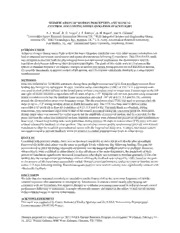
NASA Technical Reports Server (NTRS) 20110023079: Modification of Motion Perception and Manual Control Following Short-Durations Spaceflight PDF
Preview NASA Technical Reports Server (NTRS) 20110023079: Modification of Motion Perception and Manual Control Following Short-Durations Spaceflight
MODIFICATION OF MOTION PERCEPTION AND MANUAL CONTROL FOLLOWING SHORT-DURATION SPACEFLIGHT S. J. Wood1, R. D. Vanya2, J. T. Esteves3, A. H. Rupert4, and G. Clément5 1 Universities Space Research Association, Houston TX, 2 Wyle Integrated Science and Engineering Group, Houston TX, 3 MEI Technologies Inc., Houston TX, 4 U.S. Army Aeromedical Research Laboratory, Fort Rucker, AL, and 5 International Space University, Strasbourg, France INTRODUCTION Adaptive changes during space flight in how the brain integrates vestibular cues with other sensory information can lead to impaired movement coordination and spatial disorientation following G-transitions. This ESA-NASA study was designed to examine both the physiological basis and operational implications for disorientation and tilt- translation disturbances following short-duration spaceflights. The goals of this study were to (1) examine the effects of stimulus frequency on adaptive changes in motion perception during passive tilt and translation motion, (2) quantify decrements in manual control of tilt motion, and (3) evaluate vibrotactile feedback as a sensorimotor countermeasure. METHODS Data was collected on 12 Shuttle astronauts during three preflight sessions and up to four postflight sessions from landing day through the subsequent 10 days. Variable radius centrifugation (VRC) at 216 °/s in a darkened room was used to elicit otolith reflexes in the lateral plane without concordant canal or visual cues. Lateral steps to the left and right of center resulted in equivalent roll tilt steps of up to ±15°. Dynamic roll tilt was provided using sinusoidal lateral translation such that the resultant linear acceleration provided ±10° tilt at 0.15, 0.3 and 0.6 Hz, centered around the tilt-translation cross-over frequency range. The tilt-translation sled (TTS) was used to provide pitch tilt steps of up to ±7.5° during rotation about an Earth horizontal axis. The TTS was then used to deliver either sinusoidal ±10° pitch tilt or fore-aft translation at 0.15, 0.3 and 0.6 Hz. The peak linear acceleration, during translations, was maintained equivalent to that of the stimuli presented during the sinusoidal pitch tilt. Perception during single sines was assessed by verbal reports for the amplitude of perceived motion, and by a joystick for the phase between the actual and perceived motion. Separate measures were obtained for perceived tilt and translation at head level. Closed-loop nulling tasks were performed during random tilt steps or sum-of-sines (TTS only) with and without vibrotactile feedback of chair position. The sum-of-sines motion profile synchronized pitch tilt with fore-aft translation to align the resultant gravitoinertial vector with the longitudinal body axis. A simple four-tactor system was implemented to provide feedback when tilt position exceeded predetermined levels in either device. RESULTS Consistent with previous studies, there was an increased sensitivity to static tilt in roll shortly after spaceflight. Perceived tilt in the pitch plane was the same as preflight levels within one day following landing. The gain for perceived roll or pitch tilt during sinusoidal oscillations was unchanged postflight relative to preflight. However, when subjects were oscillated in either lateral or fore-aft planes at the same frequencies, the magnitude of their perceived translation significantly increased immediately after flight, and returned to baseline gradually (TTS). On landing day the manual control performance without vibrotactile feedback was reduced by >30% based on the gain or the amount of tilt disturbance successfully nulled. Manual control performance tended to return to baseline levels within 1–2 days following landing. Root-mean-square position error and tilt velocity were significantly reduced with vibrotactile feedback. DISCUSSION We infer that the increased sensitivity to translation results from a shift in the cross-over frequency of otolith- induced responses after adaptation to microgravity. Decrements in manual control shortly after landing are consistent with our hypothesis that adaptive changes in vestibular processing correspond to reduced manual control performance following G-transitions. A simple vibrotactile sensory aid improves the ability to null out tilt motion within a limited range of motion disturbances. ACKNOWLEDGEMENT This work was supported by Centre National d’Etudes Spatiales and the NASA Non-exercise Physiological Countermeasures (NxPCM) Project. Abstract prepared for submission to: 2012 NASA Human Research Program Investigators’ Workshop, February 14 - 16, 2012, Westin Galleria, 5060 West Alabama, Houston, TX 77056.
